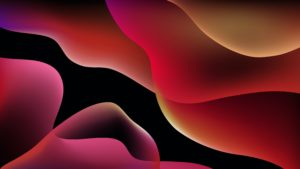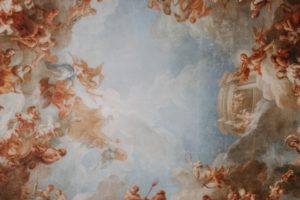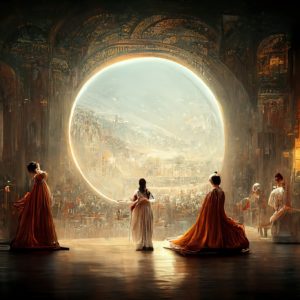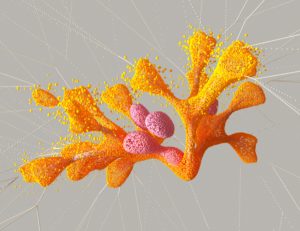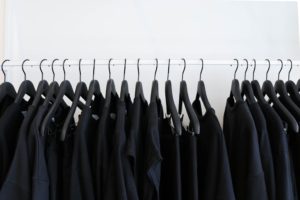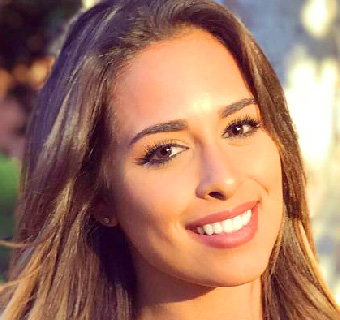Table of Contents
Have you ever wondered how Artificial Intelligence (AI) is impacting the world of art? AIArt refers to artwork that is created or assisted by artificial intelligence, it takes many forms such as digital images, videos, and even sculptures. AIArt is a rapidly growing field that has the potential to change the way we think about art and creativity.
AIArt can also have an impact on the way art is created and thought about in terms of creativity and authorship. As AI-generated art becomes more prevalent, it raises questions about the nature of creativity and authorship, and whether the AI should be considered the author of the art or the person who created the AI. Some argue that the AI should be considered the author, while others argue that the human who created the AI should be considered the author.
In this post, we will explore the different forms of AIArt and how it’s impacting creators.
Instagram artists could be particularly impacted by the rise in AIArt. To learn more about the Insta artists out there, check out our blog on 15 artists on Instagram.
Generative art
Photo by Richard Horvath on Unsplash
Generative art is a form of art that is created using algorithms, which are sets of instructions that a computer follows to complete a task. The artist sets specific parameters, such as color schemes, shapes, and patterns, and the algorithm uses these parameters to create the final artwork (Pearson 2011). This process can involve a degree of randomness, which allows for a wide range of possibilities and unique outcomes.
Generative art has been around for decades, but with the advancements in AI technology, it has become even more sophisticated and diverse. In the past, the algorithms used in generative art were relatively simple and limited in their capabilities.
However, with the development of AI, the algorithms used in generative art have become much more complex and powerful. This has allowed for the creation of more intricate and detailed artworks, as well as the exploration of new forms of visual expression (Pearson 2011).
One of the key advantages of generative art is that it allows artists to create art in ways that would be difficult or impossible to achieve manually. For example, an artist could set parameters for an algorithm to create an image that evolves over time, or to generate an infinite number of unique images. This has opened up new possibilities for artists, who can use generative art to explore new forms of creativity and expression.
Despite the advancements in AI technology, generative art is still a relatively new and rapidly evolving field.
Neural style transfer
Photo by brooklyn on Unsplash
Neural style transfer is a technique that uses AI models to apply the style of one image to another image. This allows artists to take a photo of a landscape, for example, and use an AI model to give it the style of a painting by Monet (Jing, n.d.). This technique uses deep learning algorithms to analyze the style of one image and apply it to another, resulting in a new image that is a combination of the original image and the style of the second image.
If you are interested in transforming any of your photos without AI technology, read up on how in this blog on Photography Hack for Instagram Content.
One of the benefits of this technique is that it allows artists to explore a wide range of styles and techniques, from impressionist to abstract. This creates the possibility to combine the real world with the artistic imagination, resulting in a new form of art that can be difficult or impossible to create manually. It also allows artists to experiment with new styles and techniques, giving them the ability to create unique and interesting images that would not be possible with traditional methods.
Neural style transfer has been used in a variety of applications including digital art, photography, and even video. It has been used to create a wide range of styles, from impressionist to abstract, and it allows artists to combine the real world with the artistic imagination (Jing, n.d.). The use of AI technology in this technique also allows for a greater degree of precision and control, allowing artists to create images that are highly detailed and realistic.
Negative Perspective on AIArt using Neutral Style Transfer
As the AI model is used to generate the final artwork, some may question the role of the human artist in the creative process. Artist David O’Reily spoke out to say these technologies “undermine the works of creators of all kinds, most obviously photographers, illustrators, and concept artists who shared their work online, and never asked to be included in a proprietary learning model.”
Positive Perspective on AIArt using Neutral Style Transfer
Via New York Times
On the other hand, James Allen, winner of the Colorado State Fair’s first prize in fine art, believes that it is good. He was able to create a painting and win for its quality despite not doing any physical painting. The committee at the fair stated “We think this brings up a great conversation. With advancing technology, the discussion of AI and art helps the Fair evolve from year to year.” They soon created a new category for AIArt to compensate for the advancing technology and its involvement in art.
The conversation this prompts is sticky in general, and it has to account for all the creators and artists and the multiple uses for AI beyond just replicating techniques.
Evolutionary art
Evolutionary art is a form of generative art that utilizes evolutionary algorithms to create new images. These algorithms work by creating a population of images, which are then evolved over time through a process of selection and recombination (Fogel, 2006). The selection process involves selecting the best images from the population and using them as the basis for creating new images.
The recombination process involves combining the selected images to create new variations, which are then evaluated based on certain criteria (Fogel, 2006). This process is repeated over time, with the goal of finding new forms of visual expression.
One of the key features of evolutionary art is its ability to explore the vast space of possible images and find new forms of visual expression that are not easily discoverable by human artists. It also allows the artist to create new forms of art that are difficult or impossible to create manually.
Evolutionary art also provides an efficient method of generating new images that can be used in a wide range of applications, such as digital art, graphic design, and architectural visualization.
The use of evolutionary algorithms in art also raises important questions about the nature of creativity and authorship. In evolutionary art, the artist is not creating the final artwork in a traditional sense, but rather setting the parameters for the algorithm and allowing it to evolve the images. This raises questions about who should be considered the “author” of the artwork, and whether the artwork should be considered a unique creation or simply a product of the algorithm.
In short, evolutionary art is a powerful tool for artists, designers, and researchers to explore the space of possible images, and find new forms of visual expression.
Looking to run an epic influencer marketing campaign on social media? NeoReach has the best experience in creating viral campaigns that convert on social media. Sign up here!
GAN-generated art
Photo by DeepMind on Unsplash
A Generative Adversarial Network (GAN) is a type of deep learning algorithm that is used to generate new images, videos, animations, and even 3D models. The algorithm is composed of two parts: the generator and the discriminator. The generator is trained to create new images from scratch, while the discriminator is trained to determine if an image is real or generated. The two parts of the algorithm work together to improve the quality of the generated images.
GANs can be trained to create images of anything from realistic photographs to abstract patterns. This makes them a powerful tool for creating highly detailed and realistic art. Artists can use GANs to generate new forms of visual expression that would be difficult or impossible to create manually. GANs are also used to create animations, videos, and even 3D models.
Moreover, GANs can be used in a variety of fields such as computer vision, natural language processing, and speech recognition. They have a wide range of applications such as image synthesis, image-to-image translation, and text-to-image synthesis.
It can be difficult to determine if an image is real or generated, which raises questions about the authenticity of the art.
AIArt in visual art, music, photography, and fashion
Photo by No Revisions on Unsplash
There are different ways in which AIArt is being used to create new forms of art that would be difficult or impossible to create manually. In visual art, AI is used to generate new forms and styles. In music, AI is used to compose new songs and to improvise in real time. In photography, AI is used to enhance images and create new visual effects. In fashion, AI is used to design new patterns, fabrics, and garments.
- In visual art, AI-assisted painting software has been used by artists like Zolloc to create vibrant and colorful digital paintings that are highly detailed and complex. This software allows the artist to quickly experiment with different color schemes and brushstrokes, making it possible to create highly detailed and intricate works of art in a relatively short amount of time. If you are ever interested in viewing some digital art, make sure to check out our blog on Top 15 Digital Art INstagram Accounts.
- In music, AI-assisted music production software like Amper Music has been used by musicians and composers to generate new tracks, by inputting certain parameters like genre, tempo, and mood, the software creates entire songs. We also have a great blog on Top Influencer Spotify Playlist if you’re looking for great beats, Ai-assisted or not.
- In photography, AI-assisted cameras like Google Clips use machine learning algorithms to automatically take pictures of interesting moments, like a baby’s first steps or a dog catching a Frisbee, so that the photographer doesn’t have to be constantly pressing the shutter button.
- In fashion, AI-assisted fashion design software has been used by companies like Zalando to create new and unique clothing designs. The software allows the company to quickly experiment with different patterns, colors, and fabrics, making it possible to create highly detailed and intricate clothing designs in a relatively short amount of time. This may lead to an uprise in fast fashion, however.
To combat this, check out our blog on Alternatives to Fast Fashion.
What Does This Mean for Creators?
Creators, specifically artists, can be particularly impacted as well as the art industry as a whole when it comes to the rise of AIArt.
The art industry can cover multiple areas of artistic expression. Painting, photography, music, and fashion are just a few. The industry mainly operates on the production of art by individuals and the purchase of that art by others. For example, if you were to produce a song, you’d receive compensation for that song if you were to sell it to a production company. You might even be able to receive royalties on that song.
When art is able to be pushed out at a rapid rate by those who are not even artists but have a good grasp of software and AI technology, this affects the individuals who produce art the traditional way. For these creators, their art will likely be limited in some ways, as humans cannot manually do some things in the same style and rate as sophisticated technology.
The Good
The value of authentic man-made art will likely increase.
With so many pieces of art out there created by something without the same level of skill or creative identity as a human who has been studying art all of their life, authentic work will likely be sold at a premium because of its scarcity. Thus, art made by humans will be highly valued.
Not to mention, computer-generated art calls into question how software engineers and others who use the technology will go about copyright protection issues. Can something not created by people really have copyright protection like human-made art does? This is new territory for the art world, which may lead to replicas of sophisticated AIArt that will eventually decrease the original art of the AI system. There is little information on the dilemma now, but it is something to consider.
The Bad
The technology takes the place of humans. Humans have been creating art for centuries and continue to do so today. The possibility of creators now being replaced by computers is startling.
Greg Rutowski, a concept artist and illustrator, fears this rise in technology saying “It’s been just a month. What about in a year? I probably won’t be able to find my work out there because [the internet] will be flooded with AI art… That’s concerning.”
Creators can potentially be pushed out of the industry in favor of, essentially, robots.
What’s more, artificial intelligence is trained on an accumulated database of art created by real people. This art, gathered and used without permission or compensation, generates an entirely new conversation of not just authorship, but plagiarism.
The Ugly
The internet has joined in on making fun of the new AIArt that has been flooding social media. A Twitter account racked up more than one million followers because of its “weird Dall-E Generations”. Looking at the Twitter account titled “Weird Ai Generations”, many commented on how horrible AI software is at creating hands. The account even went so far as to mock the technology’s ugly hand-making inability in a post.
— no context memes (@weirddalle) January 22, 2023
While AIArt has the potential to be produced at a faster pace, it still faces many (sometimes hilarious) problems that humans who create art manually don’t have to deal with.
Until these kinks get worked out, creators’ positions in the art industry are seemingly secured.
Conclusion
Overall, AIArt is a rapidly growing field that is pushing the boundaries of what is possible in the world of art and raising important questions about the nature of creativity and authorship.
There are many different forms of AIArt, including generative art, which is created using algorithms with some degree of randomness, neural style transfer, which allows artists to apply the style of one image to another, evolutionary art, which “evolves” images over time, and GAN-generated art, which can create highly detailed and realistic images from scratch.
AIArt is also being used in visual art, music, photography, and fashion to create new forms and styles. While AIArt is opening up new possibilities for creators, it is also raising important questions about the nature of originality, ownership, and ethics. It is important to consider how AIArt is impacting the way we create and think about art.
References:
- Pearson, M., & Watz, M. (2011). Generative art: A practical guide using processing. Manning Publications.
- Jing Y;Yang Y;Feng Z;Ye J;Yu Y;Song M; (n.d.). Neural style transfer: A Review. IEEE transactions on visualization and computer graphics. Retrieved January 28, 2023, from https://pubmed.ncbi.nlm.nih.gov/31180860/
- Fogel, D. B. (2006). Evolutionary computation: Toward a new philosophy of Machine Intelligence. John Wiley & Sons.
- Goodfellow, I., Pouget-Abadie, J., Mirza, M., Xu, B., Warde-Farley, D., Ozair, S., Courville, A., & Bengio, Y. (2020). Generative Adversarial Networks. Communications of the ACM, 63(11), 139–144. https://doi.org/10.1145/3422622





